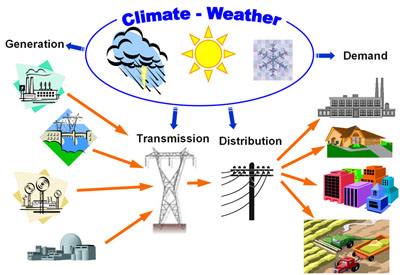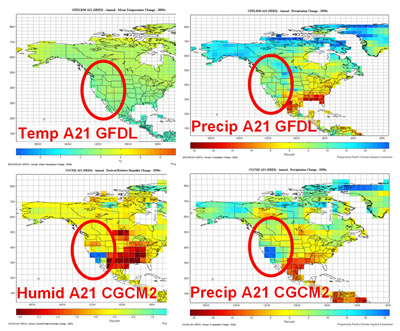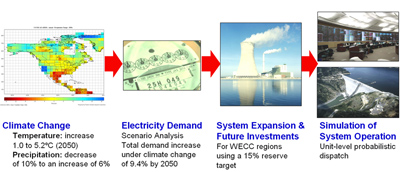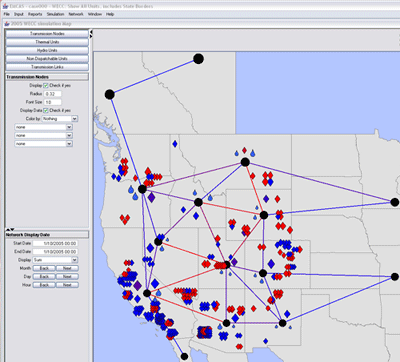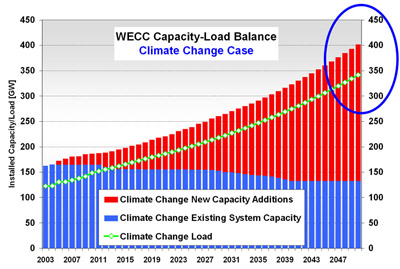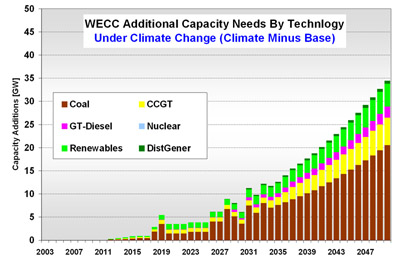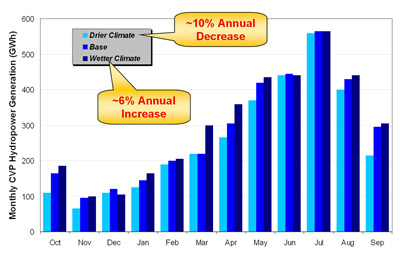| Center for Energy, Environmental, and Economic Systems Analysis (CEEESA) |  |
Research Areas:
Energy, Environment, and
Economics
National and Homeland
Security
Infrastructure Assurance
Emergency Preparedness
Social Dynamics
Policy Analysis
Core Capabilities:
Systems Analysis
Modeling, Simulation, and
Visualization
Complex Adaptive Systems
Decision Support and Risk
Management
Information Sciences
Climate Change Impacts on the Electric Power System in the Western United StatesBackground: Future climate change is projected to vary substantially across regions. Changes in regional temperature and precipitation patterns may have significant implications for our existing and future power system infrastructure. Weather and climate may affect all major aspects of the electric power sector, including electricity generation, transmission and distribution systems, and end-user demand for power (see Figure 1).
At thermal power plants, electricity generation becomes less efficient as the ambient air temperature increases. Hydropower plants are also affected by climate change. Factors such as precipitation, snow pack levels, and the timing of snow melting affect stream flow and reservoir levels. Other technologies that utilize renewable energy resources are affected by a changing climate as well. For example, solar technologies are affected by cloud cover and solar insolation. A change in wind patterns may result in a noticeable impact on future wind power generation. At the transmission level, thermal expansion of transmission and distribution power lines causes line sag, decreasing the amount of power that can be securely transported through lines. Thermal line expansion is exacerbated by higher ambient air temperature. During high-load periods, reduced transmission line capability increases congestion problems in some regions, thereby increasing the use of more expensive generating power sources while reducing generation levels at units that operate at lower cost. On the demand side, higher temperatures during summer months in warm regions lead to more demand for electricity to run air conditioners and refrigerators. On the other hand, warmer winter temperatures in cold regions may reduce the demand for electricity because less space heating will be required. Methodology: In this analysis, we use results from regional climate models to examine the impacts of projected changes in temperature and precipitation on the development and operations of the power system in the Western United States. Figure 2 illustrates some of the expected regional changes in climate from two commonly used climate models. As Figure 2 shows, these general circulation models project that temperature, humidity, and precipitation will change in the region.
Figure 3 shows the steps in our analysis. First, we translate information from the climate models (temperature and precipitation) into changes in electricity demand and hydro power generation. We then estimate the impact on system expansion and future infrastructure investment requirements. Finally, we run a probabilistic dispatch model to determine the effect of future climate changes on operational costs.
We examined four scenarios to evaluate the potential effects of climate change on electricity demand, as well as on power supply. The scenarios include a baseline case, in which we assumed that the climate would not change, and three warmer climate scenarios with varying degrees of future precipitation levels — ranging from a drier climate to a wetter one. We measured Impacts in terms of changes in investment requirements, fuel and generation mix, emissions of greenhouse gases and criteria pollutants, and thermal power water withdrawals and consumption. Our methodology included the use of a long-term investment algorithm that takes into account interdependencies between hydroelectric, thermal power, and non-dispatchable resources, such as wind turbines. We also included temporal aspects associated with hydropower energy constraints, wind variability, thermal power plant availability, and hourly load profiles. Thermal power plant availability and resulting generation and fuel consumption are based on maintenance outage schedules and a probabilistic dispatch algorithm that accounts for random forced outages. We are in the process of extending our analysis by taking into account the transmission grid in the Western United States using our newest analysis tool, the Electricity Market Complex Adaptive System (EMCAS). Figure 4 shows the system configuration we are currently testing. The western grid is divided into various zones with aggregate transfer capabilities among the zones. We used information from the Western Electricity Coordinating Council (WECC) to develop this configuration. EMCAS uses a direct-current optimal power flow (DC-OPF) routine to analyze transmission flows.
Results: Under the warmer climate scenarios, we assumed that the average temperature would gradually increase by 5.2 degrees Celsius by the year 2050 over the baseline temperature. We chose on purpose the upper range of climate warming forecasts made under the U.S. Climate Change Science Program (CCSP, 2007) to look at extreme conditions. This warmer temperature is projected to increase the demand for electricity by more than 9%. By 2050, the peak demand for electricity is expected to be about 342 GW (Figure 5), compared with 312 GW under the baseline scenario; that is, demand is 29.4 GW higher than under the baseline scenario.
To reliably meet the increased peak load, approximately 34 GW of additional generating capacity will need to be constructed. Most of this additional capacity will use coal as its primary energy source, followed by natural gas-fired technologies (see Figure 6). Generation technologies that rely on renewable energy sources, such as wind and solar, will also be used to meet the increased demand for electricity. In terms of net present value (NPV), the capital investment cost to build the additional capacity (above the baseline case) is projected to be about $8.9 billion in 2005 dollars. The NPV for additional fuel and variable operating and maintenance (O&M) costs over the analysis period is about $36 billion, or about 4.9% higher than the base case. Total climate-change-related costs are estimated to be $45 billion.
We analyzed two additional climate change scenarios as shown in Figure 7. The first assumes both warmer temperatures and lower hydrological conditions, resulting in a 10% decrease in hydropower production relative to the base case. The second hydrological scenario assumes a 6% increase in hydropower production. Hydropower assumptions are based on a study conducted by the California Department of Water Resources (CalDWR, 2006).
A warmer climate, in combination with drier conditions, is projected to increase the NPV of fuel purchases and variable O&M costs above the base case by about $61 billion through 2050 (Figure 8). This increase is attributable mainly to higher utilization rates of relatively expensive peaking technologies, such as natural gas-fired gas turbines. However, if the climate becomes wetter than the current climate, but still warmer, production cost increases are expected to be smaller: approximately $25 billion above the base case over the entire analysis period. Another aspect of climate change that would increase the cost of energy production, but is not included in the current analysis, is the increased pressure on utility fuel prices. As the demand for electricity swells, consumption of fossil fuels at power plants will also increase. The price of natural gas is particularly sensitive to supply and demand balances.
In addition to costs, we examined fresh water consumption and CO2 emissions. Under the climate change scenarios, both fresh water consumption by WECC thermal-electric power plants and CO2 emissions are expected to be about 10% higher than in the baseline case. Another aspect of the analysis that may require more examination is the impact of these higher CO2 emissions (above the base scenario) on the climate. This example underlines the importance of looking at the climate change problem from many different angles by incorporating society's reactions to climate change into the climate change equation. These reactions may either help to mitigate the problem, or they may exacerbate climate change. The study and our finding should be viewed as a preliminary investigation of the problem of climate change impacts on the power system in the Western United States. Although many aspects of our analysis, such as the inclusion of about 2,000 individual generating units and the compilation of control area data to estimate hourly loads, were performed at a refined level of granularity, many refinements to the analysis should be undertaken in the future. For example, in addition to the feedbacks in energy, economic, and environmental systems, more detailed analysis should be performed on the effects of climate change on a more refined geographical scale, including a detailed treatment of the transmission system (we have already started on this). Such an analysis will also allow for a more precise estimate of both hourly demands and the effects of climate on the operations of power production and transmission facilities. References: California Department of Water Resources (CalDWR), 2006, Progress on Incorporating Climate Change into Planning and U.S. Climate Change Science Program (CCSP), Effects of Climate Change on Energy Production and Use in the United States, Synthesis and Assessment Product 4.5, October. Additional Resources: For more information on this analysis, download the following documents (in pdf format):
For more information, contact CEEESA |
| U.S. Department of Energy Office of Science | UChicago Argonne LLC |
| Privacy & Security Notice | Contact Us | Search |
